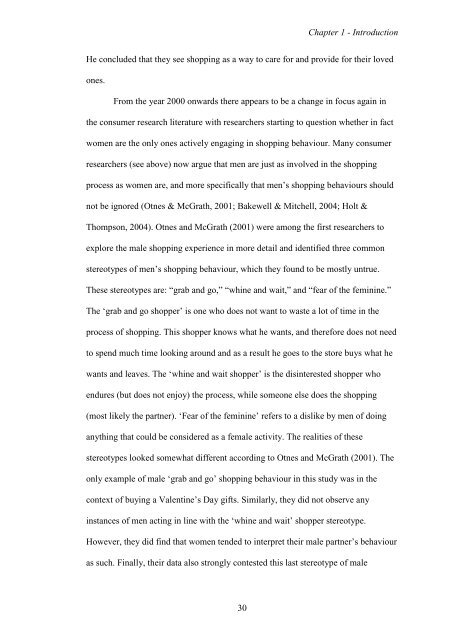CHAPTER 1 - University of Exeter
CHAPTER 1 - University of Exeter
CHAPTER 1 - University of Exeter
Create successful ePaper yourself
Turn your PDF publications into a flip-book with our unique Google optimized e-Paper software.
30<br />
Chapter 1 - Introduction<br />
He concluded that they see shopping as a way to care for and provide for their loved<br />
ones.<br />
From the year 2000 onwards there appears to be a change in focus again in<br />
the consumer research literature with researchers starting to question whether in fact<br />
women are the only ones actively engaging in shopping behaviour. Many consumer<br />
researchers (see above) now argue that men are just as involved in the shopping<br />
process as women are, and more specifically that men’s shopping behaviours should<br />
not be ignored (Otnes & McGrath, 2001; Bakewell & Mitchell, 2004; Holt &<br />
Thompson, 2004). Otnes and McGrath (2001) were among the first researchers to<br />
explore the male shopping experience in more detail and identified three common<br />
stereotypes <strong>of</strong> men’s shopping behaviour, which they found to be mostly untrue.<br />
These stereotypes are: “grab and go,” “whine and wait,” and “fear <strong>of</strong> the feminine.”<br />
The ‘grab and go shopper’ is one who does not want to waste a lot <strong>of</strong> time in the<br />
process <strong>of</strong> shopping. This shopper knows what he wants, and therefore does not need<br />
to spend much time looking around and as a result he goes to the store buys what he<br />
wants and leaves. The ‘whine and wait shopper’ is the disinterested shopper who<br />
endures (but does not enjoy) the process, while someone else does the shopping<br />
(most likely the partner). ‘Fear <strong>of</strong> the feminine’ refers to a dislike by men <strong>of</strong> doing<br />
anything that could be considered as a female activity. The realities <strong>of</strong> these<br />
stereotypes looked somewhat different according to Otnes and McGrath (2001). The<br />
only example <strong>of</strong> male ‘grab and go’ shopping behaviour in this study was in the<br />
context <strong>of</strong> buying a Valentine’s Day gifts. Similarly, they did not observe any<br />
instances <strong>of</strong> men acting in line with the ‘whine and wait’ shopper stereotype.<br />
However, they did find that women tended to interpret their male partner’s behaviour<br />
as such. Finally, their data also strongly contested this last stereotype <strong>of</strong> male
















